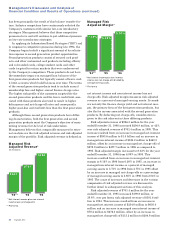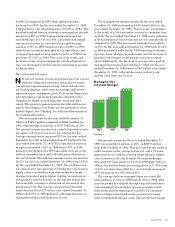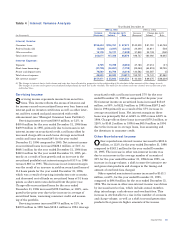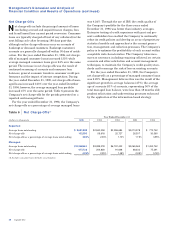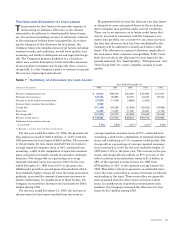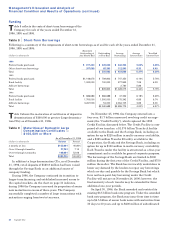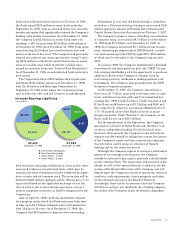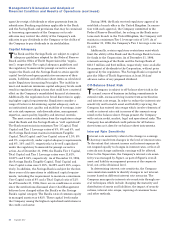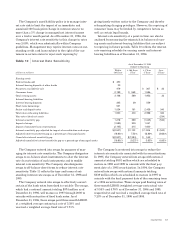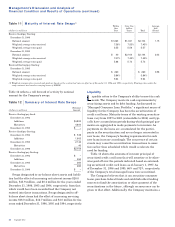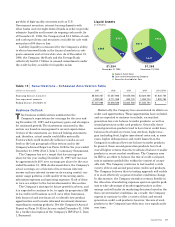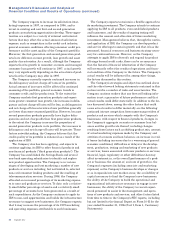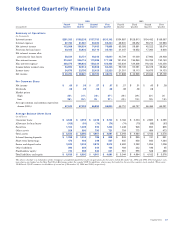Capital One 1996 Annual Report Download - page 34
Download and view the complete annual report
Please find page 34 of the 1996 Capital One annual report below. You can navigate through the pages in the report by either clicking on the pages listed below, or by using the keyword search tool below to find specific information within the annual report.Capital One
Management’s Discussion and Analysis of
Financial Condition and Results of Operations (continued)
32
upon the receipt of dividends or other payments from its
subsidiaries. Banking regulations applicable to the Bank
and the Saving Bank and provisions that may be contained
in borrowing agreements of the Company or its sub-
sidiaries may restrict the ability of the Company’s sub-
sidiaries to pay dividends to the Company or the ability of
the Company to pay dividends to its stockholders.
Capital Adequacy
The Bank and the Savings Bank are subject to capital
adequacy guidelines adopted by the Federal Reserve
Board and the Office of Thrift Supervision (the “regula-
tors”), respectively. The capital adequacy guidelines and
the regulatory framework for prompt corrective action
require the Bank and the Savings Bank to attain specific
capital levels based upon quantitative measures of their
assets, liabilities and off-balance sheet items as calculated
under Regulatory Accounting Principles. The inability to
meet and maintain minimum capital adequacy levels could
result in regulators taking actions that could have a material
effect on the Company’s consolidated financial statements.
Additionally, the regulators have broad discretion in apply-
ing higher capital requirements. Regulators consider a
range of factors in determining capital adequacy, such as
an institution’s size, quality and stability of earnings, inter-
est rate risk exposure, risk diversification, management
expertise, asset quality, liquidity and internal controls.
The most recent notifications from the regulators catego-
rized the Bank and the Savings Bank as “well capitalized”.
The Bank must maintain minimum Tier 1 Capital, Total
Capital and Tier 1 Leverage ratios of 4%, 8% and 4%, and
the Savings Bank must maintain minimum Tangible
Capital, Total Capital and Core Capital ratios of 1.5%, 8%
and 3%, respectively, under capital adequacy requirements,
and 6%, 10% and 5%, respectively, to be well capitalized
under the regulatory framework for prompt corrective
action. As of December 31, 1996, the Bank’s Tier 1 Capital,
Total Capital and Tier 1 Leverage ratios were 11.61%,
12.87% and 9.04%, respectively. As of December 31, 1996,
the Savings Bank’s Tangible Capital, Total Capital and
Core Capital ratios were 9.18%, 16.29% and 9.18%, respec-
tively. In addition, the Savings Bank is subject for the first
three years of its operations to additional capital require-
ments, including the requirement to maintain a minimum
Core Capital ratio of 8% and a Total Capital ratio of 12%.
As of December 31, 1996, there are no conditions or events
since the notifications discussed above that Management
believes have changed either the Bank’s or the Savings
Bank’s capital category. The Bank’s ratio of common equity
to managed assets was 4.92%. These capital levels make
the Company among the highest capitalized institutions in
the credit card sector.
During 1996, the Bank received regulatory approval to
establish a branch office in the United Kingdom. In connec-
tion with such approval, the Company committed to the
Federal Reserve Board that, for so long as the Bank main-
tains such branch in the United Kingdom, the Company will
maintain a minimum Tier 1 leverage ratio of 3.0%. As of
December 31, 1996, the Company’s Tier 1 leverage ratio was
11.13%.
Additionally, certain regulatory restrictions exist which
limit the ability of the Bank and the Savings Bank to trans-
fer funds to the Corporation. As of December 31, 1996,
retained earnings of the Bank and the Savings Bank of
$113.7 million and $4.6 million, respectively, were available
for payment of dividends to the Corporation, without prior
approval by the regulators. The Savings Bank is required to
give the Office of Thrift Supervision at least 30 days’
advance notice of any proposed dividend.
Off-Balance Sheet Risk
The Company is subject to off-balance sheet risk in the
normal course of business including commitments to
extend credit, excess servicing income from securitization
and interest rate swaps. In order to reduce the interest rate
sensitivity and to match asset and liability repricing, the
Company has entered into swaps which involve elements of
credit or interest rate risk in excess of the amount recog-
nized on the balance sheet. Swaps present the Company
with certain credit, market, legal and operational risks. The
Company has established credit policies for off-balance
sheet items as it does for on-balance sheet instruments.
Interest Rate Sensitivity
Interest rate sensitivity refers to the change in earnings
that may result from changes in the level of interest rates.
To the extent that interest income and interest expense do
not respond equally to changes in interest rates, or that all
rates do not change uniformly, earnings will be affected.
Prior to the Separation, the Company’s interest rate sensi-
tivity was managed by Signet, as part of Signet’s overall
asset and liability management process at the corporate
level, not at the divisional level.
In determining interest rate sensitivity, the Company
uses simulation models to identify changes in net interest
income based on different interest rate scenarios. The
Company manages its interest rate sensitivity through sev-
eral techniques which include changing the maturity and
distribution of assets and liabilities, the impact of securiti-
zations, interest rate swaps, repricing of consumer loans
and other methods.


